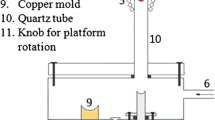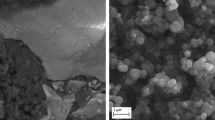Abstract
Experiments have been conducted at 1873 K (1600 °C) to study the kinetics of decarburization of Fe-Cr-C levitated droplets containing 10, 17, and 20 wt pct Cr using argon–carbon dioxide gas mixtures containing up to 30 pct CO2, at flow rates of 100, 1000, 3000 and 12200 mL min−1. It was found that chromium did not have a strong influence on the kinetics of decarburization while showing only minor effects on the extent of carbon removal. The results indicate that, for high carbon concentrations in the melt, the decarburization rates were controlled by mass transfer in the gas phase. Conventional formulation of governing mass transport numbers did not adequately describe the experimental observations made in this work. The observed rates are consistently higher than the values predicted using either the Ranz–Marshall correlation or the Steinberger–Treybal equation. A new correlation has been proposed to express the decarburization kinetics of levitated droplets for gas-flows in the range of Reynolds numbers between 2 and 100. The experimentally-derived model was found to be in excellent agreement with rate data derived from studies conducted by other researchers using levitated droplets.












Similar content being viewed by others
Abbreviations
- A :
-
Area of droplet surface (cm2)
- Ar :
-
Archimedes number \( \left( { = \frac{Gr'}{{Re^{2} }}} \right) \)
- C bulk :
-
Carbon concentration in bulk metal (wt pct)
- C surface :
-
Carbon concentration at the gas–metal interface (wt pct)
- C t :
-
Total molar concentration in gas phase (mol cm-3
- C p :
-
Heat capacity of gas (J g−1 K−1)
- D AB :
-
Mutual diffusion coefficient in gas phase (cm2 s−1)
- d p :
-
Diameter of the droplet (cm)
- f :
-
Coefficient in Eq. [9]
- Gr′:
-
Mean Grashof number (=Gr m + Gr H(Sc/Pr)0.5)
- Gr m :
-
Grashof number for mass transfer \( \left( { = \frac{{\rho_{\text{g}} gd_{\text{p}}^{3} \left( {C_{\text{i}} - C_{\text{b}} } \right)}}{{\mu_{\text{g}}^{2} }}} \right) \)
- Gr H :
-
Grashof number for heat transfer \( \left( { = \frac{{gd_{\text{p}}^{3} \left( {T_{\text{i}} - T_{\text{b}} } \right)}}{{T_{\text{f}} \mu_{\text{g}}^{2} }}} \right) \)
- J i :
-
Flux of diffusion species i (mol cm−2 s−1)
- k :
-
Thermal conductivity of gas (J cm−1 s−1 K−1)
- k g :
-
Gas transfer coefficient (cm s−1)
- k l :
-
Liquid transfer coefficient (cm s−1)
- k x :
-
Mass transfer coefficient \( ({\text{mol}}\,{\text{cm}}^{ - 2} \,{\text{s}}^{ - 1} \,{\text{atm}}^{ - 1} ) \)
- M :
-
Molecular weight of gas mixture \( ({\text{g}}\,{\text{mol}}^{ - 1} ) \)
- M C :
-
Atomic weight of carbon \( ({\text{g}}\,{\text{mol}}^{ - 1} ) \)
- m :
-
Coefficient in Eq. [9]
- n :
-
Coefficient in Eq. [9]
- P :
-
Total pressure (atm)
- Pr :
-
Prandtl number \( \left( { = \frac{{\mu_{\text{g}} C_{\text{p}} }}{k}} \right) \)
- R :
-
Gas constant (\( {\text{cm}}^{3} {\text{atm}}\,{\text{mol}}^{ - 1} \,{\text{K}}^{ - 1} \))
- Ra :
-
Rayleigh number (=Gr′Sc)
- Re :
-
Reynolds number \( \left( { = \frac{{d_{\text{p}} v\rho_{\text{g}} }}{{\mu_{\text{g}} }}} \right) \)
- Sc :
-
Schmidt number \( \left( { = \frac{{\mu_{\text{g}} }}{{\rho_{\text{g}} D_{\text{AB}} }}} \right) \)
- Sh :
-
Sherwood number \( \left( { = \frac{{d_{\text{p}} k_{\text{g}} }}{{D_{\text{AB}} }}} \right) \)
- T f :
-
Film temperature (K) \( \left( { = \frac{{T_{\text{i}} + T_{\text{b}} }}{2}} \right) \)
- t :
-
Time (s)
- T E :
-
Effective temperature of gases (K) (=0.83T f)
- T b :
-
Bulk gas temperature (K)
- T i :
-
Gas–metal interface temperature (K)
- v :
-
Relative velocity between gas and droplet (cm s−1)
- W :
-
Mass of the droplet (g)
- \( X_{{{\text{CO}}_{2} }}^{\text{b}} \) :
-
Mole fraction of CO2 in the bulk gas
- \( X_{{{\text{CO}}_{2} }}^{i} \) :
-
Mole fraction of CO2 on the gas–metal interface
- γ :
-
Coefficient in Eq. [9]
- β :
-
Coefficient in Eq. [9]
- μ g :
-
Gas viscosity (g cm−1 s−1)
- ρ :
-
Melt density (g cm−3)
- ρ g :
-
Gas density (g cm−3)
References
A. Chatterjee, C. Marique and P. Nilles: Ironmaking Steelmaking, 1984, vol. 11 (3), pp. 117-131.
M. Lv, R. Zhu, X. Wei, H. Wang and X. Bi: Steel Res. Int., 2012, vol. 83 (1), pp. 11-15.
A. McLean, R.A. Heard, G.F. Garrido, and R.G.H. Lee: Proc. 3rd Int. Conf. Clean Steel, Inst. Metals, London, 1986, pp. 226–30.
C.T. Jensen, M.F. Erspamer, J.F. Oliver, T.A. Bruce, R.A. Heard, and A. McLean: Electr. Furn. Conf. Proc., ISS, 1987, vol. 45, pp. 57–63.
H. Wang: Ph.D. Dissertation, Royal Institute of Technology, Stockholm, Sweden, 2010.
H. Wang, N.N. Viswanathan, N.B. Ballal and S. Seetharaman: High Temp. Mater. Processes, 2009, vol. 28 (6), pp. 407-419.
D.R. Sain and G.R. Belton: Metall. Trans. B, 1976, vol. 7B, pp. 235-244.
D.R. Sain and G.R. Belton: Metall. Trans. B, 1978, vol. 9B, pp. 403-407.
F.J. Mannion and R.J. Fruehan: Metall. Trans. B, 1989, vol. 20B, pp. 853-861.
C.P. Petit and R.J. Fruehan: Metall. Mater. Trans. B, 1997, vol. 28B, pp. 639-645.
K. Ito, K. Amano and H. Sakao: Trans. Iron Steel Inst. Jpn., 1984, vol. 24 (7), pp. 515-521.
N.J. Simento, H.G. Lee and P.C. Hayes: Steel Res., 1998, vol. 69 (8), pp. 318-324.
N.J. Simento, P.C. Hayes and H.G. Lee: ISIJ Int., 1999, vol. 39 (12), pp. 1217-1223.
R.J. Fruehan and L.J. Martonik: Metall. Trans. B, 1974, vol. 5B, pp. 1027-1032.
L.A. Baker, N.A. Warner and A.E. Jenkins: Trans. Metall. Soc. AIME, 1964, vol. 230, pp. 1228-1235.
N.H. El-Kaddah and D.G.C. Robertson: Metall. Trans. B, 1978, vol. 9B, pp. 191-199.
H. Sun and R.D. Pehlke: Metall. Mater. Trans. B, 1995, vol. 26B, pp. 335-344.
P.A. Distin, G. D. Hallett, and F. D. Richardson: J. Iron Steel Inst., 1968, vol. 206, pp. 821-33.
D. Widlund, D.S. Sarma, and P.G. Jönsson: ISIJ Int., 2006, vol. 46 (8), pp. 1149-1157.
L.A. Baker, N.A. Warner and A.E. Jenkins: Trans. Metall. Soc. AIME, 1967, vol. 239, pp. 857-864.
L.A. Baker and R.G. Ward: J. Iron Steel Inst., 1967, vol. 205, pp.714-717.
N. Frossling: Beitraege zur Geophysik, 1938, vol. 52, pp. 170-216.
W.E. Ranz and W.R. Marshall: Chem. Eng. Prog., 1952, vol. 48, pp. 141-146.
R.L. Steinberger and R.E. Treybal: AIChE J., 1960, vol. 6 (2), pp. 227-232.
H.G. Lee and Y.K. Rao: Metall. Trans. B, 1982, vol. 13B, pp. 403-409.
W.G. Mathers, A.J. Madden Jr. and E.L. Piret: Ind. Eng. Chem., 1957, vol. 49 (6), pp. 961-968.
H.G. Lee and Y.K. Rao: Metall. Trans. B, 1982, vol. 13B, pp. 411-421.
N.J. Simento, P.C. Hayes and H.G. Lee: ISIJ Int., 1998, vol. 38 (7), pp. 690-696.
W.R. Paterson and A.N. Hayhurst: Chem. Eng. Sci., 2000, vol. 55, pp.1925-1927.
A.E. Hamielec, W.K. Lu and A. McLean: Can. Metall. Q., 1968, vol. 7 (1), pp. 27-33.
L.A. Greenberg and A. McLean: Trans. Iron Steel Inst. Jpn., 1974, vol. 14 (6), pp. 395-403.
Acknowledgments
Appreciation is expressed to the Natural Sciences and Engineering Research Council of Canada who provided funding in support of this project.
Author information
Authors and Affiliations
Corresponding author
Additional information
Manuscript submitted December 19, 2013.
Appendix
Appendix
Assuming an ideal gas phase, the density is calculated from the relationship:
Data for viscosity, inter-diffusivity, heat capacity, and thermal conductivity are available from AspenONE Engineering Suite—Heat Exchanger Design.
CO2 Mole Fraction | ρ g, Density at T f | μ g, Viscosity at T f | C p, Heat Capacity at T f | k, Thermal Conductivity of Gas at T f |
|---|---|---|---|---|
2 | 0.000452 | 0.000558 | 0.532 | 0.000460 |
6 | 0.000454 | 0.000561 | 0.560 | 0.000464 |
10 | 0.000456 | 0.000552 | 0.600 | 0.000461 |
15 | 0.000458 | 0.000560 | 0.636 | 0.000462 |
20 | 0.000460 | 0.000537 | 0.679 | 0.000464 |
25 | 0.000463 | 0.000529 | 0.717 | 0.000470 |
30 | 0.000465 | 0.000522 | 0.755 | 0.000482 |
CO2 Mole Fraction | ρ g, Density at T E | μ g, Viscosity at T E | C p, Heat Capacity at T E | k, Thermal Conductivity of Gas at T E |
|---|---|---|---|---|
10 | 0.000456 | 0.000552 | 0.594 | 0.000393 |
30 | 0.000465 | 0.000522 | 0.738 | 0.000411 |
Rights and permissions
About this article
Cite this article
Wu, P., Yang, Y., Barati, M. et al. Decarburization of Levitated Fe-Cr-C Droplets by Carbon Dioxide. Metall Mater Trans B 45, 2211–2221 (2014). https://doi.org/10.1007/s11663-014-0126-8
Published:
Issue Date:
DOI: https://doi.org/10.1007/s11663-014-0126-8




